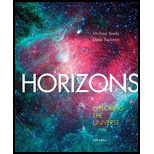
Horizons: Exploring the Universe (MindTap Course List)
14th Edition
ISBN: 9781305960961
Author: Michael A. Seeds, Dana Backman
Publisher: Cengage Learning
expand_more
expand_more
format_list_bulleted
Question
Chapter 15, Problem 8P
To determine
The number of particle Earth captured per second by the region covering 100 m2.
Expert Solution & Answer
Want to see the full answer?
Check out a sample textbook solution
Students have asked these similar questions
If you stood on Earth during its formation, during which it captured about 1.4 ✕ 1011 particles per second, and watched a region covering 310 m2, how many impacts would you expect to see in an hour? (Notes: The surface area of a sphere is 4πr2. Hint: Assume that Earth had its current radius of 6,378 km.)
[......] impacts
In the previous lab, we calculated the area in between Mars' and Jupiter's orbit to be ~1.6e18 km2. Since there are roughly 750,000 asteroids, how much area (in km2) is available for one asteroid? Use this calculation to argue whether you are likely (or not) to hit an asteroid while flying through the asteroid belt.
(Hint: To answer the first part of the question, find the area per asteroid)
The Tunguska asteroid is estimated to have had a diameter of 50 m, and to have produced an explosion equivalent to 10 megatons of TNT (1 megaton = 4.2 x 1015 joules). Assume that the asteroid was a sphere with density 2 g/cm3. Using the kinetic energy formula K = ½ mv2, where m is the mass and v is the speed, to estimate the speed of the asteroid. Assume that all kinetic energy is converted into the energy of the explosion.
Give your answer in km/s with one significant figure.
Chapter 15 Solutions
Horizons: Exploring the Universe (MindTap Course List)
Ch. 15 - What produced the helium now present in the Sun’s...Ch. 15 - What produced the iron and heavier elements like...Ch. 15 - What evidence can you cite that disks of gas and...Ch. 15 - According to the solar nebula theory, why is the...Ch. 15 - Why does the solar nebula theory predict that...Ch. 15 - Prob. 6RQCh. 15 - If you visited another planetary system, would you...Ch. 15 - Why is almost every solid surface in our Solar...Ch. 15 - What is the difference between condensation and...Ch. 15 - Why don’t Terrestrial planets have rings like the...
Ch. 15 - How does the solar nebula theory help you...Ch. 15 - How does the solar nebula theory explain the...Ch. 15 - What does the term differentiated mean when...Ch. 15 - What processes cleared the nebula away and ended...Ch. 15 - Why would astronomically short lifetime of gas and...Ch. 15 - Prob. 16RQCh. 15 - What evidence can you cite that planets orbit...Ch. 15 - Why is the existence of “hot Jupiters” puzzling?...Ch. 15 - How Do We know? The evidence is overwhelming in...Ch. 15 - How Do We know? How can scientists know anything...Ch. 15 - If you could visit another planetary system while...Ch. 15 - Prob. 2DQCh. 15 - If the solar nebula hypothesis is correct, do you...Ch. 15 - If you observed the Solar System from the nearest...Ch. 15 - Prob. 2PCh. 15 - Prob. 3PCh. 15 - Prob. 4PCh. 15 - Prob. 5PCh. 15 - Prob. 6PCh. 15 - Suppose that Earth grew to its present size in 1...Ch. 15 - Prob. 8PCh. 15 - Prob. 9PCh. 15 - Prob. 1LTLCh. 15 - Why do astronomers conclude that the surface of...Ch. 15 - Prob. 3LTL
Knowledge Booster
Learn more about
Need a deep-dive on the concept behind this application? Look no further. Learn more about this topic, physics and related others by exploring similar questions and additional content below.Similar questions
- Why is it more useful to classify meteorites according to whether they are primitive or differentiated rather than whether they are stones, irons, or stony-irons?arrow_forwardExplain the role of impacts in planetary evolution, including both giant impacts and more modest ones.arrow_forwardHow do the risks of dying from the impact of an asteroid or comet compare with other risks we are concerned about, such as dying in a car accident or from heart disease or some other natural cause? (Hint: To find the annual risk, go to the library or internet and look up the annual number of deaths from a particular cause in a particular country, and then divide by the population of that country.)arrow_forward
- Which step(s) listed in the previous question can be eliminated in models that form Jovian planets in thousands of years, a time frame that solves the Jovian problem? Order the following steps in the formation of a Terrestrial planet chronologically: gravitational collapse, accretion, outgassing, condensation, and differentiation.arrow_forwardWhy should you expect lo to suffer more impacts per square kilometer than Callisto?arrow_forwardWhy are there so many impact craters on our neighbor world, the Moon, and so few on Earth?arrow_forward
- The smallest detail visible through Earth-based telescopes is about 1 arc second in diameter. What linear size does that correspond to on Mercury when Mercury is at a distance of 1 AU? Can Caloris Basin be resolved? (Hint: Use the small-angle formula, Eq. 3-1.) (Note: 1 AU is 1.5 108 km.)arrow_forwardLook at the map of the Hawaiian chain of islands on the right-hand page of the Concept Art: Volcanoes. Which island formed most recently? How do you know? Is the newly formed volcano of a type found on Venus, on Mars, on both planets, or on neither?arrow_forward
arrow_back_ios
arrow_forward_ios
Recommended textbooks for you

 Foundations of Astronomy (MindTap Course List)PhysicsISBN:9781337399920Author:Michael A. Seeds, Dana BackmanPublisher:Cengage Learning
Foundations of Astronomy (MindTap Course List)PhysicsISBN:9781337399920Author:Michael A. Seeds, Dana BackmanPublisher:Cengage Learning AstronomyPhysicsISBN:9781938168284Author:Andrew Fraknoi; David Morrison; Sidney C. WolffPublisher:OpenStax
AstronomyPhysicsISBN:9781938168284Author:Andrew Fraknoi; David Morrison; Sidney C. WolffPublisher:OpenStax


Foundations of Astronomy (MindTap Course List)
Physics
ISBN:9781337399920
Author:Michael A. Seeds, Dana Backman
Publisher:Cengage Learning

Astronomy
Physics
ISBN:9781938168284
Author:Andrew Fraknoi; David Morrison; Sidney C. Wolff
Publisher:OpenStax
Kepler's Three Laws Explained; Author: PhysicsHigh;https://www.youtube.com/watch?v=kyR6EO_RMKE;License: Standard YouTube License, CC-BY